Research News
- Best Paper Award: Conferred to Dr Raviteja KVNS at RAISE 2023 June 20, 2023
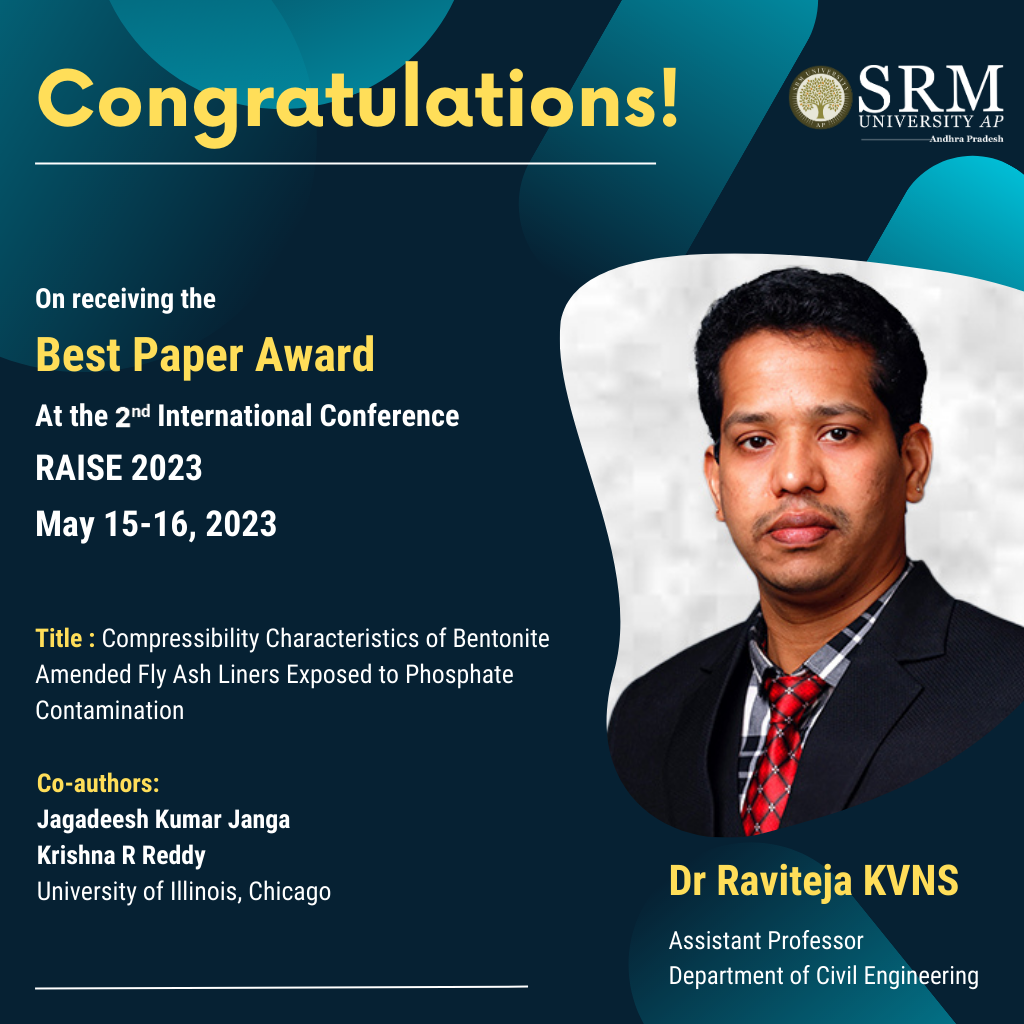
The Department of Civil Engineering is glad to announce that Dr Raviteja KVNS, Assistant Professor, has received the Best Paper Award for his paper titled “Compressibility Characteristics of Bentonite Amended Fly Ash Liners Exposed to Phosphate Contamination” at the 2nd International Conference RAISE 2023 (Recent Advances in Sustainable Environment) held on May 15-16, 2023. Dr Raviteja collaborated with Dr Janga Jagadeesh Kumar and Dr Krishna R Reddy, Civil, Materials and Environmental Engineering, University of Illinois Chicago for the research paper. Their cutting-edge research focused on developing alternate liner materials for waste containment systems.
Abstract
Waste containment systems like landfills, and impoundments are often lined with low permeable clays of hydraulic conductivity less than 10-7 cm/s. However, it is often challenging to get large volumes of low permeable clays near the project site. Conveyance of large volumes of clay from distant locations can be unsustainable due to the associated carbon emissions and energy costs, and not viable financially. Hence, there is a need to identify alternative liner materials without compromising on the containment capabilities. This study proposes the use of fly ash, amended with bentonite, as an alternative to the traditional liner systems. From preliminary studies, it is understood that a mixture of 80% fly ash amended with 20% bentonite is optimal to function as an effective liner material. However, the hydro-mechanical stability of liners needs to be investigated under different contamination scenarios. The present study reports the compressibility behavior of the proposed liner system under phosphate contamination, typically found in landfill leachate, impoundments, and stormwater retention ponds. One-dimensional consolidation tests were conducted on pure bentonite and fly ash with water to study the compressibility characteristics of individual materials. The optimum mix (80-20) was then tested at three different solutions exposure: water, 3.2 mg/L PO4-3-P and 12 mg/L PO4-3-P. It is depicted that the addition of 20% bentonite to fly ash did not affect the compressibility significantly, while the presence of phosphate contamination did not compromise the hydro-mechanical stability of the proposed liner system.
Continue reading → - Role of Covid-19 Disruption June 15, 2023

Covid-19, has wreaked havoc in ordinary life, health and finance have taken the worst hit. As for finance, people saw the loss of their livelihood, businesses collapsed and for several mid-scale and large-scale businesses, the working capital and firm performance diminished to a great extent. In the given context, Dr Pradeep Rathore Assistant Professor from The Paari School of Business (PSB) published a compelling research paper titled, “Working Capital and Firm Performance: Role of COVID-19 Disruption” in International Journal of Productivity and Performance Management” where he addresses the issue and analyses the cause.
Abstract
This study examines the performance effect of working capital for a large sample of Indian manufacturing firms in light of supply chain disruption, i.e. the COVID-19 pandemic. This study is based on secondary data collected from the Prowess database on Indian manufacturing firms listed on the Bombay Stock Exchange (BSE) 500. Panel data regression analyses are used to estimate all models. Moreover, this study has employed robust standard errors to consider for heteroscedasticity concerns. The results challenge the current notion of working capital investment and reveal that higher working capital has a positive and significant impact on firm performance. Further, it highlights that Indian manufacturing firms suffered financially post-COVID-19 as they significantly lack the working capital to run day-to-day operations. This research contributes to the scant literature by examining the association between working capital financing and firm performance in light of the COVID-19 pandemic, representing typical developing economies like India.
The study implies that organisations need to have higher working capital during an economic downturn such as COVID-19 as it takes care of present and future financing needs, to facilitate their day-to-day operational activities, and to enhance performance of both working capital and firm performance, operational and financial. The study also suggests that Managers should understand the value of working capital and advocate for higher working capital investment to address supply chain disruptions during economic downturns.
Dr Pradeep Rathore is presently working on topics related to sustainable development
Continue reading →
goals, sustainability, and solid waste management. - A Thematic Study on Green Finance June 2, 2023
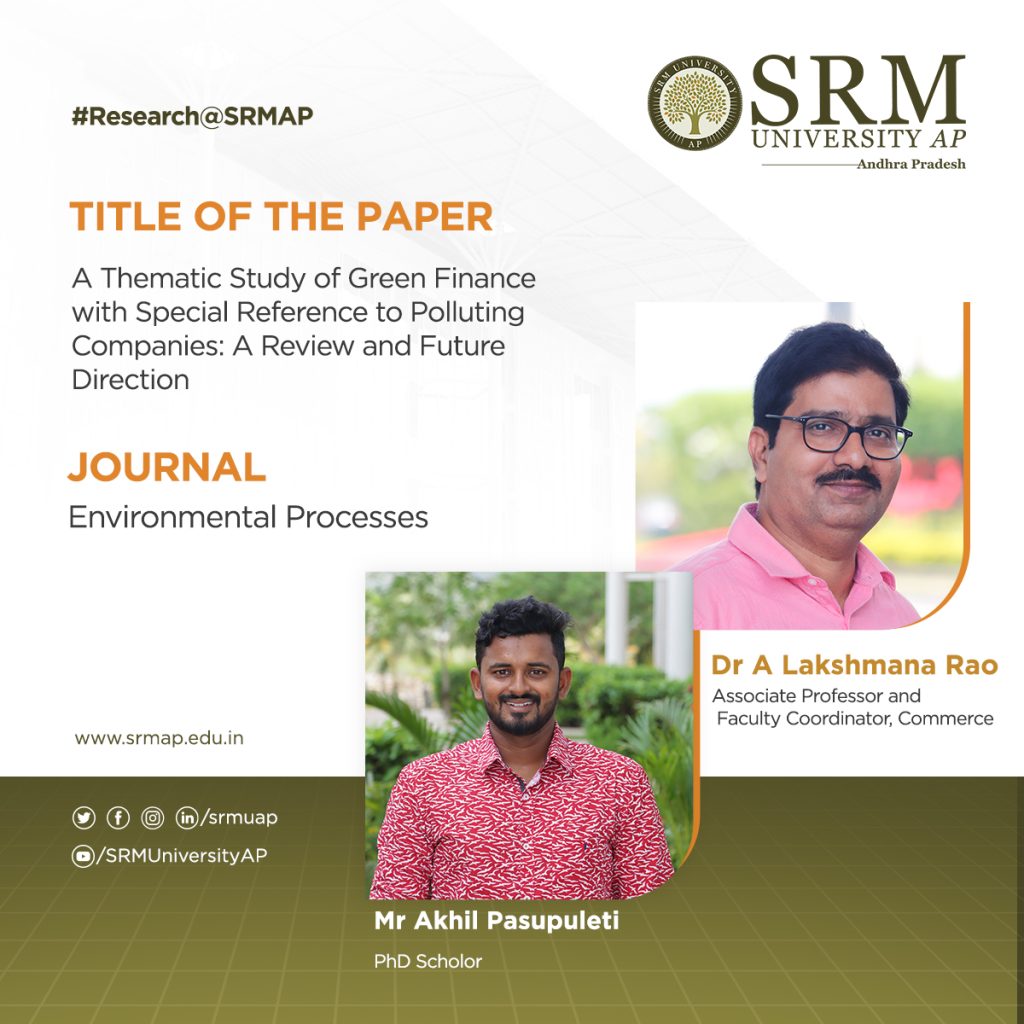 Today, we live in a world where sustainability and sustainable development are the need of the hour and amidst this, Associate Professor, Dr A Lakshmana Rao and Research Scholar, Mr Akhil Pasupuleti from the Department of Commerce have come up with their pacesetting research publication titled – “A Thematic Study of Green Finance with Special Reference to Polluting Companies: A Review and Future Direction.” The research work gives an impetus to many polluting companies to adopt green finance as an option to combat environmental pollution, this can be in the form of business strategy, energy saving, green credit, and innovation.
Today, we live in a world where sustainability and sustainable development are the need of the hour and amidst this, Associate Professor, Dr A Lakshmana Rao and Research Scholar, Mr Akhil Pasupuleti from the Department of Commerce have come up with their pacesetting research publication titled – “A Thematic Study of Green Finance with Special Reference to Polluting Companies: A Review and Future Direction.” The research work gives an impetus to many polluting companies to adopt green finance as an option to combat environmental pollution, this can be in the form of business strategy, energy saving, green credit, and innovation.Abstract
The objective of the study was to understand the phenomenon of green finance in polluting companies through a systematic literature review. The methodology involves the search, selection, classification, and categorisation of thirty-five articles on green finance in polluting companies which were analysed for the time span of eleven years, i.e., 2011–2022. The outcome of the review identified the following five themes: (i) green credit and environmental protection; (ii) green finance and green innovation; (iii) green innovation and environmental protection; (iv) green finance and investment; and (v) green innovation and firm performance. The review has put forward recommendations for further advancement in policy strengthening and the utilisation of extensive data analysis, indicating potential avenues for future research and development. The findings of the study provide insights to researchers, practitioners, and policymakers about the status of green finance in polluting companies.
Dr Lakshmana Rao Ayyagari and his student Mr Akhil Pasupuleti are working on developing future prospects of Green Finance such as ESG disclosure and reporting practices, its application and the relationship of CSR and sustainability.
Continue reading → - Market Integration of Chickpea Crop in India June 2, 2023
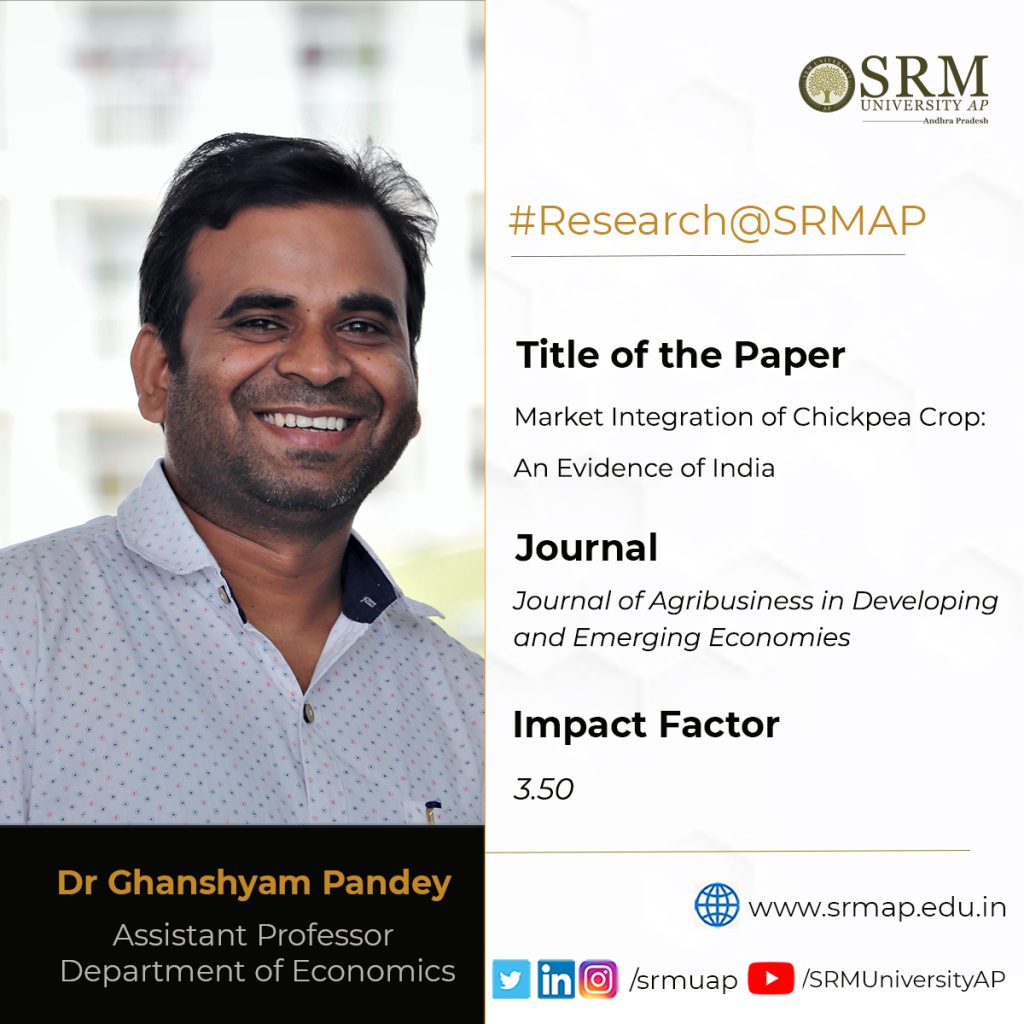
Dr Ghanshyam Kumar Pandey, Assistant Professor, Department of Economics has published a paper titled “Market Integration of Chickpea Crop: An Evidence of India”, in the esteemed Q1 Journal, Journal of Agribusiness in Developing and Emerging Economies having an impact factor of 3.50. Through this paper, Dr Pandey analyses the integration and direction of causality of prices of chickpea produce in the markets of India.
Abstract
Purpose – The purpose of this paper is to examine the market integration and direction of causality of wholesale and retail prices for chickpea legumes in major chickpea markets in India.
Design/methodology/approach – In this paper, the authors have employed the Johansen co-integration test, Granger causality test, vector autoregression (VAR), and vector error correction model (VECM) to examine the integration of markets. The authors use monthly wholesale and retail price data of the chickpea crop from select markets in India spanning January 2003–December 2020.
Findings – The results of this study strongly confirm the co-integration and interdependency of the selected chickpea markets in India. However, the speed of adjustment of prices in the wholesale market is weakest in Bikaner, followed by Daryapur and Narsinghpur; it is relatively moderate in Gulbarga. In contrast, the speed of adjustment is negative for Bhopal and Delhi, weak for Nasik, and moderate for retail market prices in Bangalore. The results of the causality test show that the Narsinghpur, Daryapur, and Gulbarga markets are the most influential, with bidirectional relations in the case of wholesale market prices. Meanwhile, the Bangalore market is the most connected and effective retail market among the selected retail markets. It has bidirectional price transmission with two other markets, i.e., Bhopal and Nasik.
Research limitations/implications – This paper calls for forthcoming studies to investigate the impact of external and internal factors, such as market infrastructure; government policy regarding self-reliant production; product physical characteristics; and rate of utilisation indicating market integration. They should also focus on strengthening information technology for the regular flow of market information to help farmers increase their incomes. Very few studies have explored market efficiency and direction of causality using both linear and nonlinear techniques for wholesale and retail prices of chickpeas in India.
Continue reading →
- Raman Signals Emitted by Pathogenic Vibrio Microorganisms and Purine Metabolites: A Comprehensive Analysis June 1, 2023
Dr Rajapandiyan Panneerselvam, Assistant Professor, Department of Chemistry, and his team have developed a method using a portable Raman spectrometer to quickly identify six common pathogenic Vibrio species that can contaminate seafood. His latest research paper Intelligent convolution neural network-assisted SERS to realise highly accurate identification of six pathogenic Vibrio, has been published in the Q1 Nature Index journal Chemical Communications, having an Impact Factor of 6.0.
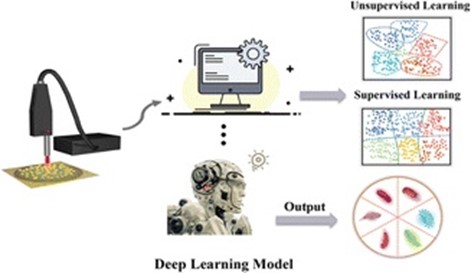 By using gold-silver nanoparticles, the study was able to accurately detect these harmful microorganisms. The new deep learning model called a convolutional neural network (CNN), outperformed traditional machine learning methods with a classification accuracy of 99.7%. The entire identification process only took 15 minutes. The researchers also discovered that the Raman signals emitted by Vibrio species are similar to signals from certain substances found in purine degradation, such as uric acid and adenine. This knowledge helps them explain why different Vibrio species produce slightly different Raman signals. Overall, the CNN-assisted Raman spectroscopy method offers a fast and accurate way to diagnose and identify harmful microorganisms responsible for food contamination.
By using gold-silver nanoparticles, the study was able to accurately detect these harmful microorganisms. The new deep learning model called a convolutional neural network (CNN), outperformed traditional machine learning methods with a classification accuracy of 99.7%. The entire identification process only took 15 minutes. The researchers also discovered that the Raman signals emitted by Vibrio species are similar to signals from certain substances found in purine degradation, such as uric acid and adenine. This knowledge helps them explain why different Vibrio species produce slightly different Raman signals. Overall, the CNN-assisted Raman spectroscopy method offers a fast and accurate way to diagnose and identify harmful microorganisms responsible for food contamination.Abstract
The utilisation of label-free Surface-Enhanced Raman Spectroscopy (SERS) technology enabled a comprehensive analysis of the connection between Raman signals emitted by pathogenic Vibrio microorganisms and purine metabolites. Through extensive research, a sophisticated Convolutional Neural Network (CNN) model was developed, demonstrating exceptional performance with an accuracy rate of 99.7% in the rapid identification of six common pathogenic Vibrio species within a mere 15-minute timeframe. This breakthrough offers a groundbreaking approach to pathogen identification, introducing a novel and efficient method to the field.
Practical Implementation of the Research
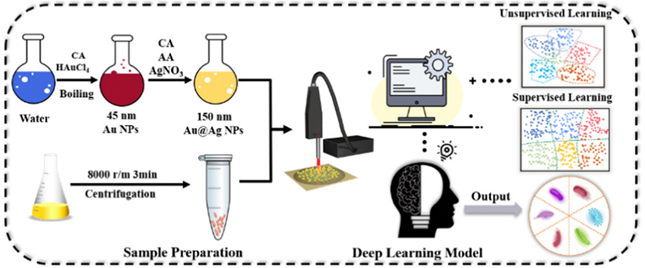 The practical implementation of label-free SERS technology combined with a deep learning CNN model enables rapid and accurate identification of pathogenic Vibrio microorganisms. This has important social implications, including improving public health and safety by quickly identifying and controlling outbreaks, enhancing food safety measures, and enabling real-time pathogen detection in resource-limited areas. The method’s speed and accuracy contribute to more informed decision-making, mitigating the spread of infectious diseases and ultimately creating a safer society.
The practical implementation of label-free SERS technology combined with a deep learning CNN model enables rapid and accurate identification of pathogenic Vibrio microorganisms. This has important social implications, including improving public health and safety by quickly identifying and controlling outbreaks, enhancing food safety measures, and enabling real-time pathogen detection in resource-limited areas. The method’s speed and accuracy contribute to more informed decision-making, mitigating the spread of infectious diseases and ultimately creating a safer society.Future Research Plans
Moving forward, future work in the field of label-free SERS technology for pathogen identification could focus on expanding the coverage to include a wider range of Vibrio species, increasing the diversity of the dataset used for training, conducting rigorous cross-validation and external validation studies, exploring integration with portable SERS devices for on-site detection, optimising the deep learning model for speed and efficiency, and investigating clinical and environmental applications. By pursuing these avenues, the research can further enhance the versatility, reliability, and real-world applicability of the method, leading to improved methods for rapid and accurate pathogen identification in various domains.
Collaborations
- Dr Jianfeng Li (College of Materials, State Key Laboratory for Physical Chemistry of Solid Surfaces, College of Chemistry and Chemical Engineering, College of Energy, School of Aerospace Engineering, Xiamen University, Xiamen 361005, China)
- Dr Lin Zhang (State Key Laboratory of NBC Protection for Civilian, Beijing 102205, China)
- Dr Zehui Chen (Xiamen City Center for Disease Control and Prevention, Xiamen 361005, China)
- Understanding Women’s Under Representation in Indian Democracy May 30, 2023
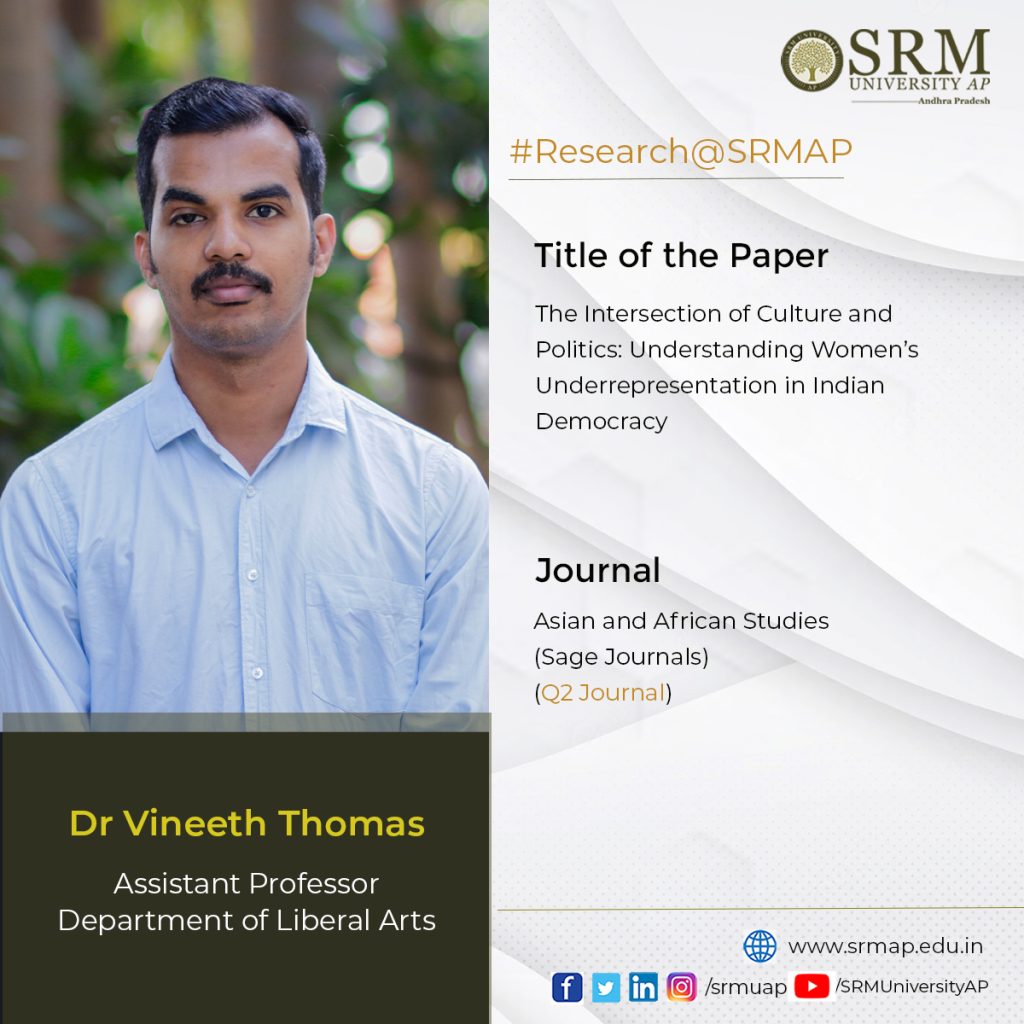
In an era where numerous policies and measures are taken to give women an equal footing with the rest of the world and where women shoulder equal responsibilities in the family and work front, the representation of women in Indian Politics still lags behind. Dr Vineeth Thomas, Assistant Professor, Department of Liberal Arts in his paper titled- “The Intersection of Culture and Politics: Understanding Women’s Under representation in Indian Democracy” in the Journal of Asian and African Studies – Sage Journals (Q2 Journal) has tried to comprehend the issue of women’s under representation in politics.
Abstract
The representation of women in Indian politics has been low and inadequate, with women comprising only 14.4% of the members of the seventeenth Lok Sabha. Despite numerous policy measures aimed at promoting women’s political representation, the under representation of women remains a persistent challenge. This study seeks to understand the intersection of culture and politics in explaining the under representation of women in Indian democracy. The findings suggest that a change in the civic political culture, through a multifaceted approach, is crucial in breaking down the glass ceiling in Indian politics.
Dr Vineeth Thomas is currently engaged in collaborative research works on Public relations, democracy and ethics, poverty in SAARC region and judicial delay in Indian high courts.
Continue reading → - DST SERB-SURE Grants Funding for Mathematics Project May 24, 2023
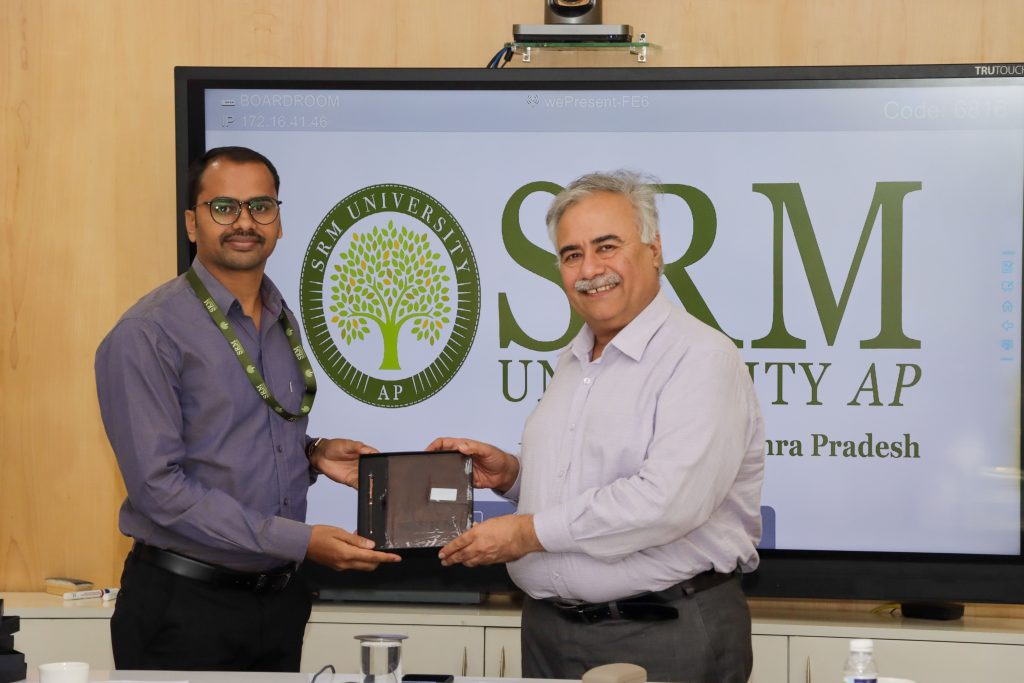
The Department of Mathematics is glad to announce that the project of Dr Sandeep Kumar Verma, Assistant Professor, titled “Investigation and development of wavelet transform and its applications in the framework of fractional Dunkl transform”, has been selected to be funded by DST, Govt. of India under SERB-SURE Scheme, securing an approved grant of 20.13 Lacs. Dr Sandeep Kumar Verma is the Principal Investigator of the project.
Title of the Project: Investigation and development of wavelet transform and its applications in the framework of fractional Dunkl transform
Approved Grant: 20.13 Lacs (As per university calculation)
Funded by: DST, Govt. of India under SERB-SURE Scheme
PI: Dr Sandeep Kumar Verma, Assistant Professor, Department of Mathematics
Project Summary: Dunkl operators are differential-difference operators associated with finite reflection groups in a Euclidean space. Dunkl transform is attracting widespread interest and giving us new perspectives on familiar topics from Harmonic Analysis and Partial Differential Equations. The fractional Dunkl transform (FRDT), which is introduced with one extra parameter, is the generalization of the well-known signal processing operations, such as the Fourier transform (FT), the fractional Fourier transform (FRFT), the Fresnel transform, Hankel transforms, fractional Hankel transforms, and the Dunkl transform. The FRDT will also find applications in the solution of optical systems, filter design, time-frequency analysis, and many others. The wavelet transforms (WT), which has had a growing importance in optics and signal processing, has been shown to be a successful tool for time-frequency analysis and image processing. It has found many applications in time-dependent frequency analysis of short-transient signals, data compression, optical correlators, sound analysis, representation of fractal aggregates, and many others.
The fractional wavelet transforms (FRWT) based on the fractional Fourier transform, which generalizes the classical wavelet transform, has proven potentially useful for signal processing, data compression, pattern recognition, and computer graphics. Thus, fractional wavelet transform gives more flexibility for time-frequency analysis than the usual wavelet transforms. As a generalization of the WT, a novel fractional Dunkl wavelet transform (FRDWT) can combine the advantages of the WT and the FRDT, i.e., it will be a linear transformation without cross-term interference and will be capable of providing multiresolution analysis and representing signals in the fractional domain. Simultaneously, compared to the Dunkl transforms, FRDT is more flexible for its one extra degree of freedom and can be used frequently in time-frequency analysis and non-stationary signal processing. Inspired by the fractional wavelet transform (FRWT), we introduce the concept of the (FRDWT), combining the idea of FRDT and WT. The proposed transform will not only inherit the advantages of multiresolution analysis of the WT, but also will have the capability of signal representations in the fractional Dunkl transform domain. Compared with the existing WT, the fractional Dunkl wavelet transform can offer signal representations in the time-fractional-frequency plane in the FRDT domain.
Continue reading → - SERB- SURE Grants: 10 projects worth 2.50 crores awarded to SRM AP May 16, 2023
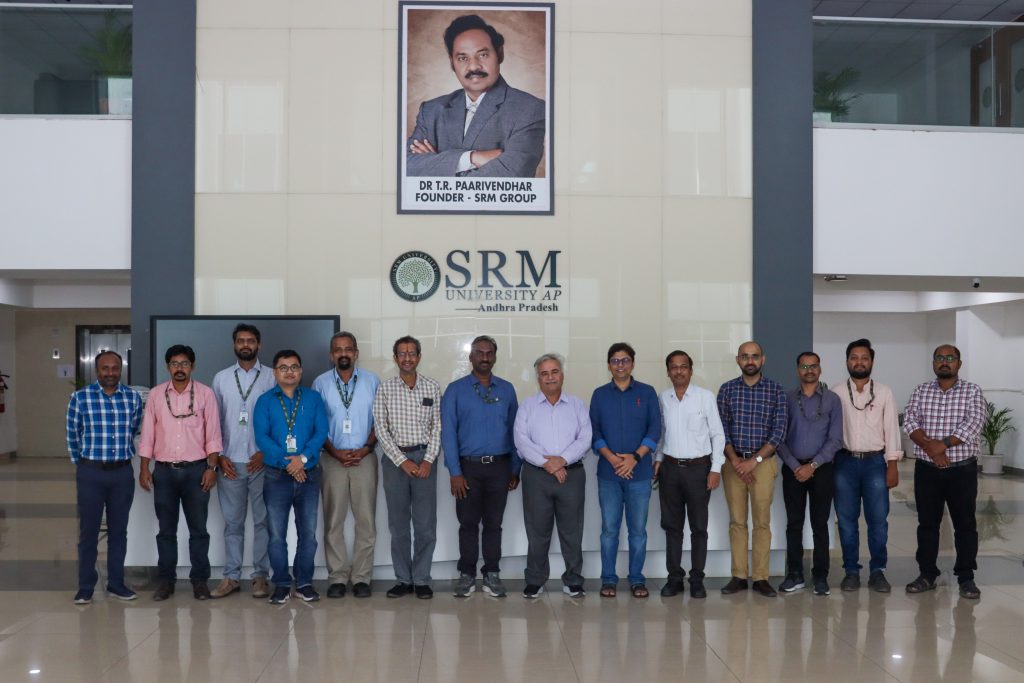
The faculty of SRM University-AP have been awarded 10 projects worth 2.50 crores from the Science and Engineering Research Board (SERB-SURE). Department of Science and Technology (DST) received a total of 2000 proposals, of which 466 were sanctioned. Among the 466 projects, 151 projects were awarded to Private Universities. Of the 151 projects approved to state private universities and colleges throughout India, the five-and-a-half-year young varsity was awarded 10 projects. 10 professors from various Science and Engineering Departments brought this incredible achievement to the university.
SERB-SURE is a research grant scheme initiated by the Science and Engineering Research Board (SERB) in India to provide financial support to young researchers in the early stages of their careers. The grants are intended to support research in basic and applied sciences, engineering, and technology and is typically granted for a period of three years.The SERB-SURE scheme is one of several initiatives by SERB to promote scientific research in India and support the development of a strong research community in the country.
“It is a milestone achievement that resonates with the University’s unparalleled commitment for excellence. We are striving towards research-intensive learning to build cutting-edge innovation for a transformative tomorrow”, commented Vice Chancellor, Prof. Manoj K Arora. The Executive Director-Research of SRM Group, Prof. Narayana Rao said that, “SRM University-AP has travailed hard to achieve the world-class scientific temperament that we now advocate, and this achievement is a testimonial recognition of all our efforts.” The prestigious grants were sanctioned to the faculty in the on-going domains of Quantum Kinetic Approach, Antimicrobial Resistance (AMR) Profiling and Changing of Hydroclimatic conditions in Bay of Bengal among 7 others.
Dean-SEAS, Prof. Ranjith Thapa said, “These research could be path-breaking and could offer a solution to many of the societal difficulties.” Prof. Jayaseelan Murugaiyan, Dr Sandeep Singh and Dr Pitchaiah Cherukuri of the Department of Biological Sciences; Dr Sabyasachi Chakrabortty, Dr V S Baswanth Oruganti of the Department of Chemistry; Dr Debabrata Pramanik, Dr Ravi Kumar and Dr Pankaj Bhalla of the Department of Physics ; Dr Sandeep Kumar Verma of the Department of Mathematics; Dr Uma Maheswar Arepalli of the Department of Civil Engineering; and Dr Kousik Das of the Department of Environmental Science and Engineering were awarded the grants.
Continue reading → - Two-Dimensional Transition Metal Oxide Layers and A method for Their Synthesis May 8, 2023
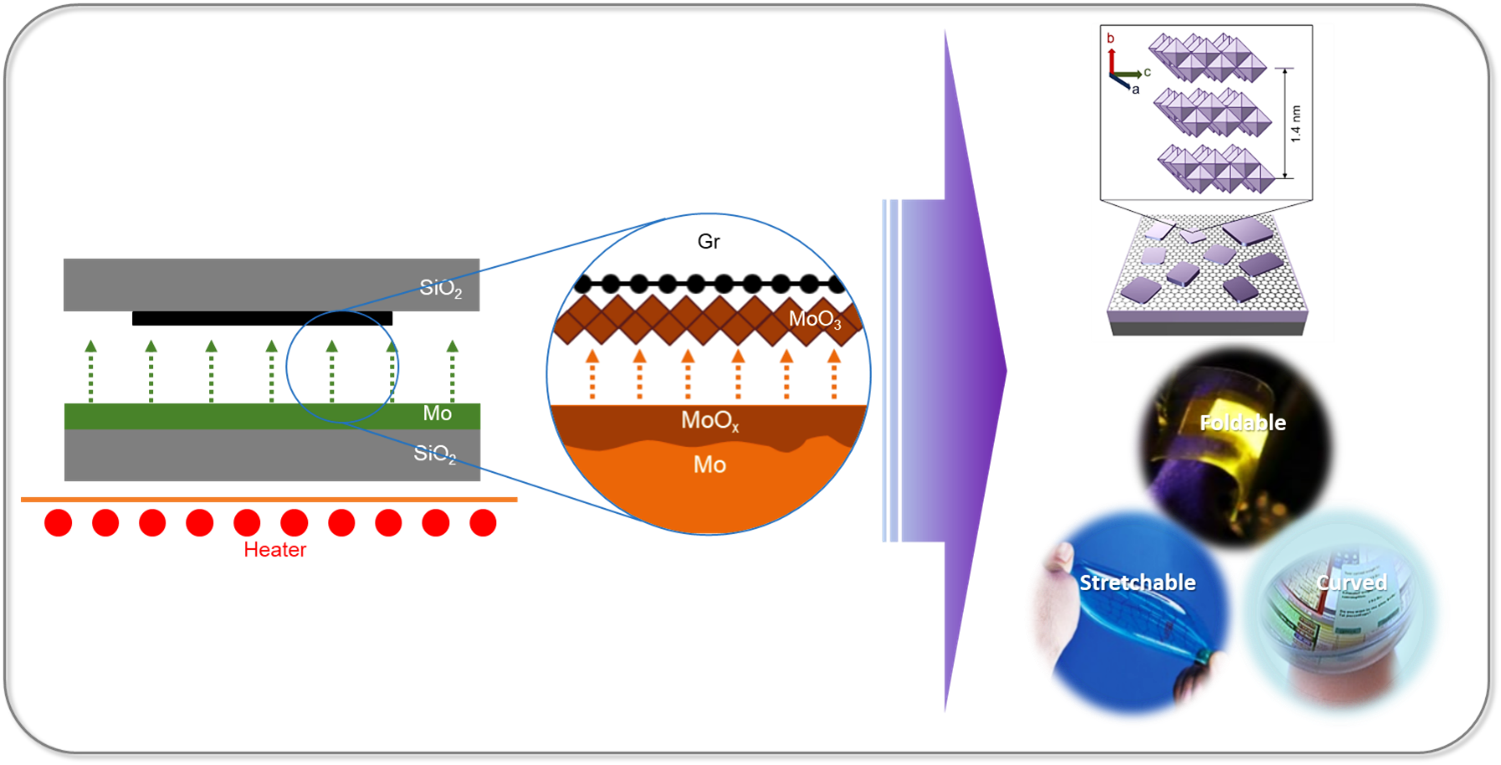 Researchers at the Department of Physics have successfully developed large-area ultra-thin 2D transition metal oxide (TMO) layers using a cost-effective and straightforward method through proximity evaporation under ambient conditions. Associate Professor Dr Jatis Kumar Dash and his students Shaik Md. Abzal, Kurapati Kalyan, and Sai Lakshmi Janga have secured a patent for their research in Two-Dimensional Transition Metal Oxide Layers and A method for their Synthesis (application no: 202241005220). They have integrated the 2D TMO layers with various other 2D materials to create nano-electronic devices. Their work demonstrates the immense potential of ultra-thin TMOs in 2D-material-based flexible electronics.
Researchers at the Department of Physics have successfully developed large-area ultra-thin 2D transition metal oxide (TMO) layers using a cost-effective and straightforward method through proximity evaporation under ambient conditions. Associate Professor Dr Jatis Kumar Dash and his students Shaik Md. Abzal, Kurapati Kalyan, and Sai Lakshmi Janga have secured a patent for their research in Two-Dimensional Transition Metal Oxide Layers and A method for their Synthesis (application no: 202241005220). They have integrated the 2D TMO layers with various other 2D materials to create nano-electronic devices. Their work demonstrates the immense potential of ultra-thin TMOs in 2D-material-based flexible electronics.Patent Background
The two-dimensional (2D) ultrathin hetero-stacked layers show unusual physiochemical properties when reduced to a few atoms in thickness. These 2D heterostructures offer significant benefits for next-generation devices. Firstly, their atomically thin 2D nanosheets provide a larger surface area due to the complete exposure of surface atoms. Secondly, edge sites in 2D nanosheets are chemically more reactive than their basal planes, and open gaps allow for the intercalation of electrolyte ions. In addition, the high mechanical strength and flexibility at atomic dimensions make them suitable for use in next-generation wearable electronics. However, growing and stacking 2D materials is challenging, and existing growth tools are complex and costly.
Future Prospects
2D materials are critical for making flexible, wearable, foldable and transparent self-powered smart electronic devices. The next generation smart electronic devices will be
Continue reading →
made of 2D materials heterostructures which will need less operating power, fewer materials consumption and will have ultimate scalability. - Delivered Lecture at the Two – day National Conference on Youth Development May 1, 2023
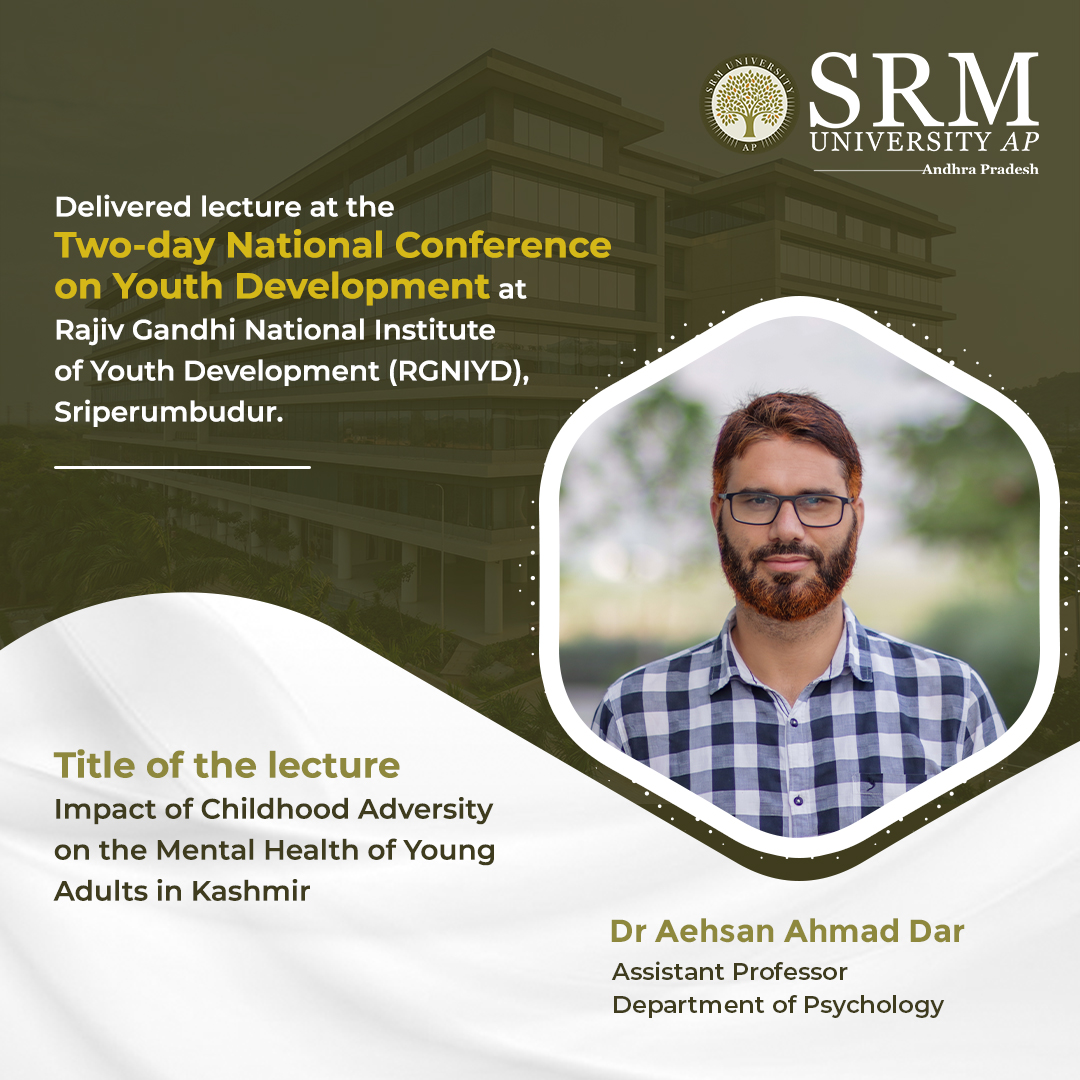 Dr Aehsan Ahmad Dar, Assistant Professor, Department of Psychology, delivered a lecture titled Impact of Childhood Adversity on the Mental Health of Young Adults in Kashmir at the Two – day National Conference on Youth Development held on March 24 and 25, 2023. Youth in the 21st Century: Prospects and Psychosocial Challenges was the theme of the conference, which was organised by the Department of Social Work and Department of Applied Psychology, Rajiv Gandhi National Institute of Youth Development (RGNIYD), Sriperumbudur, Tamil Nadu, in collaboration with ICMR – NIRT, Chennai.
Dr Aehsan Ahmad Dar, Assistant Professor, Department of Psychology, delivered a lecture titled Impact of Childhood Adversity on the Mental Health of Young Adults in Kashmir at the Two – day National Conference on Youth Development held on March 24 and 25, 2023. Youth in the 21st Century: Prospects and Psychosocial Challenges was the theme of the conference, which was organised by the Department of Social Work and Department of Applied Psychology, Rajiv Gandhi National Institute of Youth Development (RGNIYD), Sriperumbudur, Tamil Nadu, in collaboration with ICMR – NIRT, Chennai.Abstract of the Lecture
The study examines the impact of Adverse childhood experiences (ACEs) on mental health among young adults in Kashmir. A cross-sectional research design was followed to study the effect of ACEs on the mental health of Kashmiri youth by employing a multi-stage sampling method. Data were collected from 693 research participants who were studying in different colleges and universities in Kashmir, with the help of the Adverse Childhood Experiences scale and Mental Health Inventory (MHI-18). Findings revealed that various adversities during childhood, including psychological abuse, physical abuse, contact sexual abuse, household substance abuse, violent household treatment of mothers and fathers, household mental illness, and household criminal behaviour, had a significant impact on the mental health of Kashmiri youth in terms of increased anxiety, depression and loss of behavioural control and decreased positive affect.
Practical Implementation of the Findings
ACEs are traumatic events that individuals under 18 have experienced. Various individual, family, and community factors can affect a child’s likelihood of experiencing ACEs, and it causes long-term risks for mental health with the potential to carry over beyond the present generation. ACEs are linked to chronic health problems, mental illness, and adult risk-taking behaviours. There is a “dose-response relationship” between ACEs and health outcomes. Therefore, findings suggest advocating early targeted interventions to reduce ACEs and their impact on young people’s mental health in Kashmir. There is a need to design efficient measures, to enhance ACE resilience programs and ‘trauma-informed’ approaches to tackle the longer-term impact of ACEs on health and wellbeing.
Continue reading →

